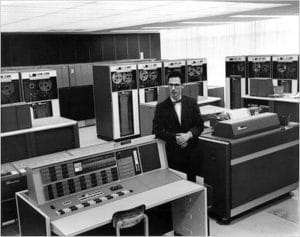Since his father was a Spanish Literature professor at the University of California in Los Angeles, Corbató enrolled at UCLA for college. That education was interrupted by World War II: he served in the U.S. Navy. During the war, Corbató’s job as an electronics technician was to “debug an incredible array of equipment being foisted on the ships,” he said, and the idea of tracking down errors and improving systems became a life-long passion. When he was released from the Navy in 1946 he enrolled at the California Institute of Technology, where he earned his bachelor’s degree in physics, and then moved to the Massachusetts Institute of Technology for his graduate studies in physics. He needed a computer for his research. “It was very laborious type work and in retrospect kind of dull,” he said in a 2006 interview with the Computer History Museum in Mountain View, Calif. “But it taught me how to get a complete hands-on feel for working with programs, organizing them, and learning the ropes of how to use a computer.” As he worked, he realized he “got more interested in the calculator than I did in the problem.” He completed his PhD in physics in 1956 and joined MIT’s Computation Center, and rose to full professor in 1965. His main problem with computers: the batch processing method they used was “infuriating” and inefficient. Computer programs were brought to the computer on punched cards, got in line with other programs, and then each one was run in turn before the output was returned to the user, usually the next day.

Corbató headed a project on computer time-sharing. He didn’t invent it, but he and his team perfected it. The first pass was called Compatible Time-Sharing System, in 1961. CTSS used a “supervisor program” to rapidly switch from user to user to provide some time with the computer; delays were nearly imperceptible. Corbató said it was like a chess master playing games with multiple opponents at the same time, stepping from board to board to make moves, so that by the time he got back to the first board, the player there had made his move. It worked. “To this day I can still remember people only realizing when they saw a real demo: ‘Hey, it talks back. Wow! You just type that and you got an answer!’” he said in a 1989 interview. He also led the follow-on project. “Multics started out as kind of a wish list of what we would like to see in a big computer system that might be made as a commercial model,” he said. AT&T’s Bell Laboratories and General Electric collaborated on the project. Multics pioneered a number of technologies and strategies still in use today, including hierarchical file systems and dynamic linking. General Electric used Multics on its high-end computer systems, and Bell Labs took their lessons learned and created Unix, which is still used today on most Internet servers. “The really frightening part is that we’ve made the computer extremely easy to use,” Corbató said in 1963. “So it will be used more and more.” He also realized that using keyboard terminals for real-time interaction with computers, sometimes from a distance, required a way to determine who was accessing the computer, and which files they were allowed to see. “Putting a password on for each individual user as a lock seemed like a very straightforward solution,” Corbató said in a 2012 interview. Obviously, they’re still used today, but he said in 2014 that the password system has become “unmanageable” in its proliferation.
Real-time computer interaction made Corbató realize that the best way to program a computer was to design software interactively; that is now known as agile software development. Corbató received the 1990 Turing Award, considered by some to be the “Nobel Prize” of computer science, “for his pioneering work in organizing the concepts and leading the development of the general-purpose, large-scale, time-sharing and resource-sharing computer systems.” In 2012, he was made a Fellow of the Computer History Museum “for his pioneering work on timesharing and the Multics operating system.” Dr. Corbató died July 12 at a nursing home from diabetes in Newburyport, Mass., 12 days after he turned 93.
